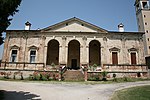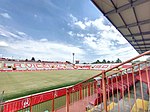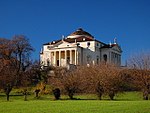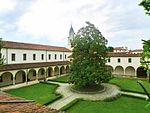Vicenza American High School
Department of Defense Education ActivitySchools in VenetoVicenza
The Vicenza American High School (VHS) is a European Department of Defense Education Activity DoDEA high school located in Vicenza, Italy, on Villaggio Della Pace, a US garrison base. Previously on Caserma Ederle, a new building was opened on Villaggio Della Pace in August 2023. Parkhill was the primary architecture firm for this project. It was founded in 1954 by Eric Hall.
Excerpt from the Wikipedia article Vicenza American High School (License: CC BY-SA 3.0, Authors).Vicenza American High School
Olson Ave, Vicenza Parco Città
Geographical coordinates (GPS) Address Website Nearby Places Show on map
Geographical coordinates (GPS)
| Latitude | Longitude |
|---|---|
| N 45.5486 ° | E 11.5826 ° |
Address
Vicenza American High School
Olson Ave
36040 Vicenza, Parco Città
Veneto, Italy
Open on Google Maps










